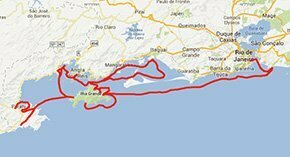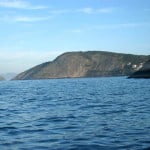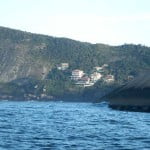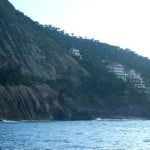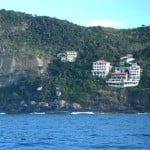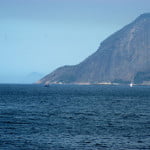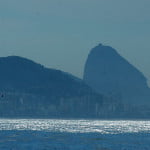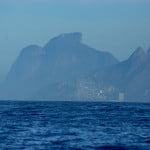Saturday, 12 – 08 – 2006.
It is 3:20 p.m. We have been sailing since 6:00 a.m. Right now we are across the Reef of Marambaia. There isn’t enough wind for the Endless Sea, we are using the motor. There are 20 miles left, in addition to the 40 we have already sailed, to reach Grande Island, in the Bay of Angra, and achieve our first destination. There is some time left before we anchor, that’s why I decided to write this trip’s logbook. We arrived in Rio for one more trip, on Thursday 10th at about 11:00 a.m. We had lunch and then went to Rio de Janeiro’s Federal University for our first interview with Professor Paulo Pereira de Gusmão, in the field of Public Policies and Natural Sciences. He explained to us his view on the Reef of Marambaia. According to Professor Gusmão, “the Brazilian coast has countless examples of what shouldn’t be done in terms of occupation”. This is the reason why to him the reef is a live laboratory, “an opportunity to create a different type of occupation”. In spite of being part of the metropolitan area of Rio de Janeiro and having one million three thousand people in the surrounding areas, especially on the continental shore where the old port of Sepetiba is, today called Itagua, which comprehends the districts of Mangaratiba, Itacuruça and Itaguai; he thinks that this area is a “live laboratory”. Marambaia Island, where the reef is, is not very occupied yet. The most important obstacle is the presence of people from the Army who divided that area in three parts: one occupied by the Army, another by the Air Force and the third by the Navy. This was partly good since the presence of the Army didn’t allow real estate speculation and predatory tourism to occur. However, this situation will change sooner or later. People from the Army will leave and then this area will be occupied. Professor Gusmão’s main concern is that this process may be different from the rest of Rio’s coast. He thinks that “second home tourism”, like that on the north coast, in the lakes’ area, until Buzios, or towards the south, in the Bay of Angra, is not an example to be followed. In those areas, they’ve been killing the goose that lays the golden egg. He adds: “The tourism expansion project in the state of Rio is shortsighted. In the high season, the districts triple the population. However, during the rest of the year, the third which remains, those people who were born and live in the area, has no purchasing power. The collected income is very little; consequently there is no basic sanitation, waste treatment, or effective garbage collection. There isn’t enough money to afford it.” According to Professor Gusmão, just a few jobs are generated by tourism. A few fishermen work as caretakers, but that’s all. Sales are scarce as well as services. Fishing is getting scarce day after day. When human occupation arrives in the Reef; new possibilities will have to be found.
Professor Gusmão also talked a little about the industrial occupation of the inner area of the reef, where there is already a port and an industrial pole and a big environmental damage left by companies which operated in the chemical field and established in the area in the 1960s. He also told us about big public and private investments scheduled until 2011.
The port is getting bigger to export soy from the Midwest and relieve Paranagua. Two refineries will be built, Petrobras’ and Grupo Ultra’s, whose projects are under a process of authorization. At last, two additional steel companies. One from Vale do Rio Doce and another from CSN. An investment of thirteen billion dollars in the next five years is estimated for this huge industrial pole.
We will be checking this soon.
On Friday 12th, the following day, we had another interview, this time at Fluminense Federal University, in Niteroi.
We talked to teachers who told us about the geological formation of the reef, RJ’s mountains, the typical coast, the coast’s islands and the formation of the Reef of Marambaia itself which occurred during the last sea transgression movement, about 20 thousand years ago. It was an excellent private lecture. They already knew our work. Some of them had already visited our site and watched a couple of TV programs. They were aware of our journey and were respectful towards us. I was happy with their acknowledgment. It was a gift. We expected to talk to one of them, but we were welcomed by three experts: Gilberto Tavares de Macedo, Andre Luiz Ferrari and Cleverson Guizan Silva, from the Geology laboratory. All this because “we have credibility and have been doing good work”. In other interviews for important TV channels, “hegemonic”, they were disappointed with the editing. In a subtle way, they made us understand that criticism is left out and compliments are shown. I believe that’s “Brazil’s official version”, the one we see on TV. I guess most people who read me know exactly what I am talking about (plim-plim – a sound often heard on Brazil’s most popular TV channel). Tomorrow morning, I will write about the explanations we had.
We are about to arrive at Grande Island, in the bay of Angra, where we are going to sleep tonight.
I want to go to the deck to look at the beautiful natural scenery. Today, near Barra, in front of the city of Rio, we saw a group of whales. I saw at least three. One was a female and its young were beside it. Sometimes they came to the surface and so near the Endless Sea that we could hear the water jets and their breath. This is a rare scene and it is possible only if you are in a sailboat. It was too good for our first sailing day.
Sunday, 13 – 08 – 2006.
We slept at the creek of Palmas, on the east side of Grande Island, a very beautiful place where in the 60s and 70s a crazy German lived as husband and wife with a female monkey. Although it is absurd and bizarre, this is not a fisherman’s tale. When I was a kid, I used to come to Grande Island by motor boat with my father and his friends and stop here. Peter’s stories and his sick preferences were famous.
We left very early in the morning to shoot the islands out of Grande Island. We started by the Creek of Parnaioca which is 15 miles away. A beautiful beach which is not yet occupied by tourism or summer visitors. Here there are only a few fishermen’s families and nothing else. As usual, they teach us how to occupy the coast. Their houses were built in the back of the beach, after the first row of trees. From the sea you scarcely see them. We got out of the boat to shoot and record. We walked to the river at the south end and returned. The sea water is clear as that of a swimming pool. The blue sky was almost free of clouds, perfect to make good programs.
From Parnaioca we went to Dois Rios Creek, leaving on the right side Jorge Greco Island. The famous prison was on Dois Rios. For a certain time, there were only political prisoners, and then it was opened for ordinary bandits. People say that the Red Command was born within its walls as well as other groups of the same sort since there were urban guerillas’ members, with political ideas, as well as murderers, thieves, rapists, all kinds of dishonest people. They learned about organization and urban guerilla in their daily contact. In 1994, after two spectacular escapes, the prison was abandoned. Ever since, every two or three years, the Press says that hotel groups have been trying to build huge resorts here.
The anger felt by these groups has been prevented by environmentalists, NGOs, and Rio’s environment agencies. Part of Grande Island is a State Park, another part is an APA, and there is also a Biological Reserve. Nevertheless, it is important to be watchful. Sooner or later, they will try again. Grande Island is a wonder, but like every island, it is fragile. The worst enemy is the fact of being near Rio de Janeiro and São Paulo, two of Brazil’s most crowded and developed states. Additionally, it is covered with the Atlantic Forest and has beautiful beaches, waterfalls, paths, mangroves, lagoons and more than 300 islands around it; all of them in the Bay of Angra.
Until last century’s mid sixties, the area was not much occupied. But after BR 101 was built in the early 70s, a road which goes alongside almost the entire Brazilian coast, it was very hard. Brazil had just gone through the “Brazilian Miracle”, the period during which the Army ruled in the country and the upper middle class as well as wealthy people were able to save money. The road, on the other hand, was built near the sea; it crossed mangroves which had been filled with land, hills which were part of the Sea Chain, covered with native forest and many beaches. As usual, there wasn’t any occupation plan. The result was predictable: chaotic and uncontrolled occupation and nobody followed the environmental legislation. Financial savings resulting from the “miracle” became summer houses. Entire beaches were occupied; fishermen sold their properties and became at most caretakers of the rich. Even the coast was occupied. Marinas, yacht clubs, hotels, resorts, pousadas and slums. Everything came with it all at once. After five, six years, the surrounding area of the bay was tremendously occupied as well as lots of islands. Real estate speculation boomed. “Paradise” was definitively contaminated.
The infrastructure of the neighboring cities such as Parati and Angra couldn’t adapt itself to the frenetic movement and was left behind. About 120 thousand people live in Angra dos Reis, the city is full of slums up the slopes of the hills (see pictures). The population has 33 thousand private homes and only 48% have waste treatment. In Parati, the situation is worse. There are 30 thousand inhabitants in 8 thousand homes. Less than 15% have waste treatment (source: IBGE, 2000). Today, it is necessary to stand this situation as well as the environmental damage; you rarely destroy what is already built. Even if it is completely illegal, which is the case of most buildings here. We also have to mention ports, plants, shipyards which were built here too.
The amount of motor boats, sailboats, jet skis which cross these seas in summer and on holidays is unbelievable. Every year thousands of leisure boats cross these waters causing accidents and very often fatal victims. This results from wrong use and imprudence. Many times I’ve helped very expensive yachts with bad pilots who literally turn them into ashes; or those who go over slabs and islands. There are many slabs submerged in the bay and not all of them have visible signals. When I come here on vacation, I can’t even anchor on the continent side of the island due to the intense traffic of boats of all types and sizes. There are too many, always with very loud music on as if nobody else existed. Motor boats make high waves and the pilots are visibly impolite. They go between anchored boats at a cruise speed as if they were in the middle of the sea. Jet skis nearly hit other boats just to show off and like a torpedo they crash right on the broadside of a boat and act like a disoriented child who tries to reach the target. It is awful. Additionally, trawlers throw trawl-nets in the Bay of Angra and Sepetiba without being bothered which results in a decreasing number of fishes. In spite of that, this area is amazingly beautiful. The Sea chain is really near the ocean. The contours show exuberant landscapes. It is still possible to see the Atlantic Forest on the steeps and hills. Although there is pollution and human waste, very often there is transparent water due to the fact that the bay is open. This is the reason why it gives us the false idea that the water is pure and well treated.
Little by little we can show you every detail.
From Dois Rios Creek, we sailed a little bit eastwards until we reached the coast which forms the creek of Lopes Mendes. I wanted to show one of the most beautiful beaches in the area and people rarely know it because it is hidden in the rocks: Caxadaço, an old port of slaves. We entered carefully sailing close to the rocks until the thin, dark sand and transparent water became visible. Wonderful. We got out of the boat again to shoot.
And then we sailed in front of Lopes Mendes, the last beach on the east side, before sailing alongside Castelhanos End. Ayrton Senna loved this scenery. He had a house in Angra and when he was here he used to take his motor boat and go to Lopes Mendes.
We sailed alongside Castelhanos and went to Céu Creek; some type of mini tropical fjord with a narrow entrance which opens to a lake surrounded by hills covered with Atlantic Forest. Occupation here is also chaotic. In past times there was only a couple of modest houses and in the back a village of non industrial fishermen. Today, a few mansions struggle for more room in this exiguous area. Floating restaurants serve yachts which are constantly coming. Remarkable bookmakers, who have just been applauded on the avenue during carnival, have also chosen Ceu Creek as a refuge. This is the reason why a mansion on the beach was built here. However, this is accepted as a normal thing and I am the only person who sees problems here. I wish this could be true. We talked to a professor from Fluminense Federal University who told us about another typical problem here. The mangrove which filled all the bottom of Ceu Creek is not recovering any more. The waves formed artificially by yachts and jet skis reach the banks and remove the thin coat of mud around the mangroves where the roots were fixed. Today you can only see a row of few mangroves and the mud was replaced by sand. This is the end. There will be no more vegetation very soon.
After having shot, we entered in the bay and reached more remarkably beautiful places: Macacos Island and Freguesia de Santana and its old church. I wanted to arrive at Macacos Island at midday. When the sun is high and you go between two islands, there is an amazingly beautiful color, something between light blue and transparent white. Unfortunately, the area was covered by clouds… this time it wasn’t possible. We continued and sailed in front of Bananal Creek and reached Aripeba end, a coast covered by houses. Some of them were built on the rock, in public areas, the Navy’s property, where it is forbidden. And then we tried to reach the Church of Santana through Bananal Creek. Contiguously, there is a slaves’ cemetery. But when we got out of the boat, we saw there was a fence and a locked gate, just the cemetery was outside. It wasn’t possible to reach the church on that side. Three, four years ago it was still possible to take that path; not any more. It seems the area was “privatized” by some new tenant… We went all the way to Freguesia Beach by motor boat passing a prominent end of Grande Island and Macacos Island. We finally arrived. There were fences from Boavista, a company from Rio de Janeiro, were we were told they had “bought” the entire area. We were able to shoot images of the beautiful colonial church, when Grande Island was some sort of quarantine area for ships whose destination was Rio de Janeiro. This area was used in the past for sugar-cane plantation. There were many sugar mills on the island in the 17th, 18th and even in the 19th centuries. And then coffee plantation was introduced.
After having shot, we went to Abraao’s village, a little bit outwards. When the prison was here, prisoners were brought to this village and then taken to Dois Rios. It was a small and modest village. Today it attracts tourism.
There are pousadas, hotels, bars and restaurants everywhere. We are going to spend the night here. Tomorrow we will try to go along the same way the prisoners used to go; through a small road from Abraao which crosses the Atlantic Forest, goes up the cliff behind the island and goes down the other side finally reaching the prison.
Monday, 14 – 08 – 2006.
We left the boat in the morning to try to meet the authorities of the State Park. We wanted a ride until Dois Rios, but red-tape stopped us. The officer told us exultantly it wasn’t possible without a previous authorization from Rio. OK, forget it.
We sailed to a very well known island in the Bay of Angra, Gipoia Island, which is between Grande Island and the continent. I wanted to show the wonderful scenery on the TV program. We stopped in front of Peri Igel’s farm; at least this is the name I knew the farm had.
It is a beautiful and typical two-floor colonial house. A whitewashed mansion with blue windows and the traditional stairs going down from the porch on the first floor to the ground. In the past I used to stop here with the Albardon, my father’s boat, to get water supply. We shot, took pictures and left. This time I wanted to show an environmental disaster caused by a resort built here.
Not far from here, on the continent, there is a very beautiful beach. Until the nineties it was partially occupied keeping its natural beauty and special charm.
It is called Tangua and there was a farm’s colonial house; a beautiful 18th century terracotta ground house with a beautiful garden with centennial imperial palm trees. On both sides and behind it there were hills covered with Atlantic Forest. A couple of years ago, “Pipa’s Beach” (this is how it was called) was sold to a hotel group. Machines came, hills were leveled and part of the forest was cut. The farm house disappeared. Awful buildings emerged instead. It was both an environmental crime and an action against historical Patrimony. This magnificent place was distorted; now it is ugly and ordinary. Whenever I come here I am shocked at this absurd view. I remember the exuberant bucolic landscape in the past; and now I cannot accept the fact it was destroyed by undertakers who were attracted by its outstanding natural beauty. However, as soon as they arrived here, they tried to turn it into some sort of Miami, lost in the middle of the rests of the Atlantic Forest and now there is a lot of concrete (see pictures). Absurd. This is the same threat that puts the most beautiful beaches and creeks of the Northeast in danger. This type of tourism should not be considered as predatory. It is worse than that. It is simply a criminal destruction.
Then we sailed to the city of Angra to fuel the Endless Sea in order to sail to the back of Sepetiba bay where the reef of Marambaia is.
The arrival was terrible. Angra is like a huge slum from afar. Little houses on the slopes of the hills, a huge urban chaos. At the port, there are from ships to structures of oil wells.
We fueled fast and left towards Zumbi End at Marambaia Island where the headquarters of Marambaia Island Navy’s Training Center are.
It was dark when we arrived. We contacted on the radio on board the local garrison who were waiting for us. We will leave the boat tomorrow to have a better idea.
Tuesday, 15 – 08 – 2006.
At 8 a.m. we were called on the radio by people from the Navy. They suggested we had an interview with the commander at 8:40 sharp. Ok, we will be there.
We left the Endless Sea and took our rubber boat at the scheduled time. The sea was rough by the strength of the Northwest wind, normally it is unpleasant because it is hot, stuffy and precedes the arrival of cold fronts. It was blowing hard.
We tied our boat beside a Navy’s motor boat docked at the wood pier. Captain Montanha was waiting for us, very nice and kind. He took us to Commander Loureiro’s office. We had an interesting talk, as well as coffee, and were protected by the air-conditioning.
Commander Loureiro summarized how the occupation of Marambaia Island occurred in a few minutes without skipping any important phase. He started by the period during which it was a strategic place to defend Rio. This is the reason why Mem de Sa’s Indians were brought here, to inspect the coast and identify the enemies’ ships in order to warn as soon as they were seen. He explained to us all this period until the arrival of the Navy, at the beginning of the 20th century, to establish a base in an unoccupied property of the Union. And then the Navy was followed by the Army which occupied the first third, the part near the continent just separated by a narrow canal reaching the reef. And then the Army occupied the third in the middle which covers practically the reef area. The third part is occupied by the Navy, the first to arrive and which kept the end of the reef and Marambaia Island itself.
It is 42.5 kilometers long. The island is elongated from the west to the east, its largest part is 5 kilometers and the narrowest is 150 meters (see nautical map). 370 non-industrial fishermen live here, they are called caiçaras. Apart from armed forces’ people, nobody else lives here. There are neither hotels nor summer houses. Thanks God. Their presence didn’t allow the heavy occupation which exists in Parati and Angra. Consequently, there is marvelous scenery and the original beauty remains practically intact.
It is really beautiful. The part occupied by the Navy there is a relief of mountains and the highest point is Marambaia Peak which is almost 700 meters high with rocks with green coverage like Pao de Açucar’s. The military facilities are on the plain and they were used as a fishermen school in the past during Getulio Vargas’ dictatorship.
After the interview, we were guided by a Sargent to visit the area; on foot, in the sun and the unmerciful heat, although it is winter time. We walked all the morning through a path which leads to several beaches towards the continent until we reached the reef; this type of sandy rope, as geologists call it, formed by the sea’s last transgression movement. This occurred when the sea water was about a hundred meters away, comparing to where it is now. As it advanced and helped by the low gradient (the land inclination) of the area; it brought a lot of sand with it and gradually formed the reef.
Its function in the ecosystem is to separate and protect the sheltered area which is inside, formed sometimes by lagoons, such as Rodrigo de Freitas as well as others in Rio, or by bays, such as Sepetiba’s and Angra’s. “If there were no reefs, there would be no mangroves in the back of the bays”, says Professor Andre Luiz Ferrari, from the Geology Laboratory of Fluminense Federal University. “This is the reason why this sand shall not be occupied; if this occurs, the area will be condemned”, he explains. Professor Andre tells that during high tide periods, the sea water advances and “eats” the beach or the reef sand which is diluted in low depth areas. As time goes by, waves bring each sand grain back; this restores the missing sand on the beach. They call it the dynamic balance. If anyone blocks this cycle of nature, this balance is destroyed and erosion comes. This is one of the reasons why it is forbidden to build on beaches; a law which is rarely obeyed in this country.
We got back to the Endless Sea at midday. We had had a good impression. Even the waste of the Navy staff is treated organically and it doesn’t pollute the environment. All the garbage is collected and taken to the continent; the human presence causes a very little impact.
Now we are sailing towards the back of the bay; towards the port itself. On the way, we passed near the reef to shoot scenes for the TV program. Paulina and Cardozo got out of the rubber boat and were shocked by the dirt. Lots of plastic and garbage on the beach…
When we arrived at the port, we wanted to visit the area used by Inga; a company which processes zinc. It was established in the area in the sixties. It broke and ended its activities in the nineties. However, it caused a significant environmental damage: contamination by heavy metal, the plant effluents established on Madeira Island; at that time the owner was a senator from Paraiba, Domicio Godinho Barreto. We started to ask every fisherman we met; however, every time they showed us a different direction. We went up one arm of the river by rubber boat and when we got there we realized we were wrong. At last, we found the right place, but it was too dark to register it. We will shoot tomorrow. We were comforted by an amazing sunset; the horizon was covered with reddish shades of all possible color blends, from light pink to blood red.
In the evening, we saw something amazing. The sky was full of stars, dark in the back and there was no moon. It was shining so brightly that it reflected on the water of the bay; sometimes making us believe that it was the horizon: you couldn’t distinguish very clearly the sea from the sky.
We went to bed in this atmosphere.
Wednesday, 16 – 08 – 2006.
We got out of the boat very early in the morning to look for Inga’s estate. This company was established on Madeira Island, in the district of Itaguai, where it caused a huge environmental damage after it broke and closed in the nineties. This is what we were told by Professor Paulo Pereira de Gusmao, who mentioned clearly huge tanks containing some sort of liquid where water and heavy metals were mixed, that is cadmium, lead and zinc.
During the rain season, in summer, this material overflows and reaches the mangrove which is around and pollutes everything, including the estuary. Oysters are not caught in this area any more. All the organisms which philter are irremediably contaminated. Besides the trouble of what to do with this residue. Today, the situation is examined by professors of the Federal University who have already suggested burying the cement area, like Chernobyl’s, as well as a controlled use. None of these suggestions have been adopted so far; there are only studies.
The scene we saw when we arrived astonished us. A huge area as big as five football fields, full of mud in the middle, on a higher level, and surrounded by water. It is a mountain of detritus left by the company which is exposed to rain water which produces rivers of detritus that go down from the top and accumulate in the form of lakes around it. This water reaches flooded areas, goes through the land and pollutes the water table and takes everything with it.
This is just one of the many traps that the future will see in the bay of Sepetiba. There will be billions invested such as two steel companies, CSN’s and Vale do Rio Doce’s, and two oil refineries (Petrobras and Ultra Group), as well as other companies causing environmental impact. I haven’t even mentioned new jobs and the arrival of lots of workers; more traffic and the increase of urban garbage. I’m not optimistic about the future of this area. I’m afraid this is one of my last visits when it was still possible to shoot the bay with life. According to Professor Gusmão, the state government agency in charge of this metropolitan area was extinct in the 80s. Since then “government authorities don’t do anything, there are no occupation plans either.”
One more time, because of these accusations, I feel that Rio’s authorities neglect environmental issues. When we recorded the TV program on the Bay of Guanabara, Dora Hess, coordinator of the Bay’s NGO , told us that “since Rosinha Mateus took power the Bay’s Council has never met.” Now, we have the same accusation, this time by someone who studies the bay of Sepetiba, one of the last unoccupied areas of Rio’s coast.
With this sad image in mind and all the information checked, we started sailing to another bay, Angra’s. We are going straight to Bracui, on the continent; and then we will visit Frade’s port in order to show examples of predatory occupation. There are summer houses on the slopes of the hills, the Atlantic Forest was turned into grass, ugly condominiums right on the shore, pinuses used as live fence, etc. We will sleep in Longa Creek, on the west side of Grande Island, which is my favorite resting place. There is only a fishermen colony on a beautiful beach and a river with waterfall. Lots of Atlantic Forest, transparent river water and sea water, and the sound of a bell-bird which peeps constantly.
Thursday, 17 – 08 – 2006.
Instead of hearing the birds singing, we heard a monotonous speech and out of tune singing. Instead of visual pollution, there was sound pollution. We arrived at Longa in the evening and an Adventist Church was established here a long time ago. It offers not only evening services, but it also amplifies them: powerful loud-speakers spread the sound throughout the bay to the entire community whether you want to it or not. We were victims of the situation. That’s what we heard from 6 to 9 p.m., a witness speech by a woman’s voice followed by ordinary chords. They insisted on starting a new and predictable situation by the sound of an electronic keyboard or a guitar out of tune. The sound we heard was so distorted that it was difficult to distinguish it. And it was endless. One of these monotonous musical sentences exhaustively repeated, typical of religious hymns. The boat was far away anchored in the middle of the bay at a depth of 13 meters; despite the distance the sound bothered us. And then we heard rumors of a speech made in a convincing manner and enthusiastically. From time to time, a chorus repeated in unison: “Hallelujah, brother.”
When the torment was about to end, the first sounds of crickets were heard. And then they started to sing again. A chorus of feminine voice was spread by the microphone. When the melody required higher notes, a frenetic cry was heard. A series of strident out of tune sounds echoed altogether. Really bad. However, the enthusiasm didn’t decrease and they continued to sing anyhow until late in the evening. And then at last there was silence and the sound of the crickets could be heard again as well as the waves breaking smoothly on the hull. Peace at last.
Why people, rich or poor, think that everybody has to hear ONLY what they say or the music they prefer? And if I want to listen to Bach?
In spite of the evening disturbances, we woke up early. At 7 a.m., the crew got up. Not me, just half an hour later.
We left the boat to shoot a cascade, a waterfall near the beach. I used to have a bath there. This time, there is little water; it’s winter, the dry season.
On our way back, going through the inhabitants’ houses, we saw something on the floor which reminded us of Fleixeiras, Ceara. Dry algae, someone breeds them here. He showed up soon; a nice gaucho (from the South of Brazil) who has been living in Longa for a couple of years.
We talked to Eric de Azevedo who is happy with the results. He uses a sort of alga from the Philippines and is helped by professors of Rio’s University as well as by experts in biology.
Algae are put in the sea in nets which are tied to anchored floating structures. 45 days later they reach the right size; then they are chosen and dried. Afterwards, they are sold to the cosmetic or pharmaceutical industry. They are also used as food.
According to the breeder, this activity generates jobs, increases the income of fishermen; additionally it increases maritime life. Any substance put in the water attracts a series of microorganisms which use it as substratum. They are fixed there, grow, develop and become food for other bigger forms of maritime life. Thus successively. During our visit, we were able to see turtles among the nets and bigger fishes at the bottom. They were all there, around this mini ecosystem, being fed, procreating, responding to the stimulus.
“It is much more profitable than the mussel breeding (a common activity in several sub-bays of Angra), seeing that the maturation time is much shorter. While algae need 45 days, it takes mussels nine months to reach the phase of being collected and consumed.”
Eric ends the conversation here with this statement. Happy with the results, he is confident of his future; he seems to be happy with his life in Longa.
And us? We have to sail. I wanted to visit Aventureiros as well as the east and south beaches; the last ones before we finish the whole tour around Grande Island. However, it is not only long, we are 15 miles away; but there is also bad weather. The cold front announced by the northeast wind arrived this morning. Everything is gray around us; it is probably raining in Parati. What a pity! To make things worse, we have to go to the city this afternoon. Yesterday, on the phone, Paulina fixed an appointment to interview IPHAN’s people this afternoon. Tomorrow, Friday, they won’t be available. I have to change my plans again. Instead of going to Aventureiros, we are sailing to Parati, I must be patient.
At 2 p.m. we anchored in front of the city. A few minutes later, lunch was ready, made by Cardozo. Rice, pork chop and sausages.
And then we rested in the cockpit and felt the wind on our faces refreshing the atmosphere.
We got out of the boat at 3 p.m. to walk around the beautiful colonial town; we took some pictures and shot before the interview. The historical center where cars are forbidden is paved with pé-de-moleque stones. The streets are narrow and most of them are under water when there are moon tides. The famous mansions are around it and most of them are well preserved and restored. Parati was founded in 1667 and it is one more city of the Brazilian coast considered National Historical Patrimony.
Afterwards, we had our talk with Cyntia Terrice from IPHAN, who explained to us about Parati’s apogee and decline. As you all know, the city grew because of the port. It was through the port that the Portuguese flew the mineral richness extracted from Minas Gerais’ soil which were brought here by Cunha’s road.
The city grew and expanded due to this activity. Much later, in the 19th century, the same port had a relevant function during coffee times, up to the moment the railroad was built. Little by little, Parati lost its importance. There were also times with sugar-cane mills and over a hundred alembics used to make white rum. Today there are only six operating.
Today the city’s main activity is tourism.
We were having coffee in a bar and I received a call from Alonso who was in the Endless Sea. Problems on board. He was asking for our help.
We went straight to the pier; we took our rubber boat and speeded up towards the sailboat anchored in the middle of the bay of Parati.
The boat was making water. A lot. Pump bombs could hardly stand such big amount of water.
One of the control valves of the hull, the one that empties the cockpit water, had exploded. Fortunately it happened here near a port, when the sailboat was anchored during the day.
I dove immediately and with a piece of cloth I filled the hole. I didn’t shut it completely; but it was enough to make the bombs empty the bulk.
As soon as we arrive in Santos we will change all of them.
One more time I must thank fortune for having this problem in a calm and quiet situation. If the control valve had broken in the middle of a night sailing with strong waves, I don’t know what would have happened. It would have been very difficult to dive and fill the hole immediately.
This was the situation in Amapa. When we grounded in the Calçoene River, we realized that the crows’ foot (the piece which holds the motor axle) was completely loose. One more time, if the piece had been loose while we were sailing, it would have been the end. The axle would have gone and there would be an enormous hole to fill.
These two problems would have made me loose my boat. Fortunately, they both occurred in very favorable situations. Does Neptune really exist and is he helping us?
Friday, 18 – 08 –2006.
I spent part of yesterday’s evening thinking in these two major problems we had and about the disastrous consequences they could have caused. Before going to bed I thanked God for being so lucky and not having any serious problem on this journey which started over a year ago. We sailed in some dangerous places of the Brazilian coast such as the North, with its canals where a couple of years ago Sir Peter Blake was murdered by pirates who stole his sailboat (Amapa).
And then we sailed in desert areas on Para and Maranhao’s coast where the police are rarely present, or the Navy. Afterwards, we faced the rest of the Northeastern Coast, with its reefs and obstructed rivers. There was an exception: we grounded in the Jequitinhonha bar, in the south of Bahia, but we were sound and safe.
Now we are entering in the Southeast, after having sailed along Espirito Santo and Rio’s coast, and there is Sao Paulo’s left. In spite of that, since the very beginning, we have already covered 4500 miles. To finish our journey, we will have to go along the south coast which is also dangerous and there are no shelters. It is the last one out of the sixteen coastal states, Rio Grande do Sul. Let the winds help us.
This morning we sailed straight to Mamangua Creek, a few miles away from the port where we are. Mamangua is some sort of tropical fjord, where the water enters more than 5 miles inside the coast, like a tongue of salt water surrounded by high hills on both sides, covered by the Atlantic Forest and ending in the back of a bay formed by rivers and mangroves. Here is Cairuçu’s APA (Environmental Protection Area), one of the few coastal areas where the monocarvoeiro can still be found, one of the biggest primates of the Brazilian forests. However, this area’s most important problem is irregular occupation. Almost all the beaches are occupied by mansions built on the sand and many beaches are illegally “privatized” by their present occupants.
They forget that beaches are public areas which belong to the Union and nobody has the right to stop anyone from visiting them.
It is amazing the silly things that the “civilized” man has made on the Brazilian coast, especially in the Southeast. I have rarely seen fishermen’s houses, the old occupants, so near the sea. In most cases, they built behind the sand, after the first row of trees; consequently, they didn’t destroy the landscape, they didn’t damage the coast’s fragile dynamic balance either.
I’ve never seen the house of a fisherman on the coast; I’ve seen at most a very modest ranch to pull their canoes to earth.
However, today ignorance and bad will reign in regard to the coastal environment.
Rich people, who are wealthier and can have more available information, destroy in a couple of years what took nature thousands to create. See pictures of this trip, Niteroi’s coast was unmercifully occupied. In Angra dos Reis the situation is about the same. Summer houses were built on the rocks or on the sand of the beaches, blocking its movement or causing erosion. And we haven’t mentioned Hotels and Resorts such as those we showed in the Northeast and now again, during this trip in Angra (see pictures).
Well, this project was designed to show good and bad aspects and we are not going to give this role up. I really wanted to shoot Mamangua to show not only the exotic beauty, the richness and diversity, but also the problems. In this case, they result from high class wrong concept of building.
The first one we shot and took pictures of is the last one built. When I was last here, three years ago, it didn’t exist. It was built on the sand of the first beach if you come from the sea. And it is not only one house, there are five! One for each son of the owner. Even the river course was changed so that the stone swimming pool, built on the sand, a few meters from the sea, was properly supplied. Up on the hill, there was deforestation to build a heliport in order to make it easy on holidays and vacation. To make things worse, the impudent owner stuck a plaque on the beach which says: “Private property. Entrance forbidden.”
Ibama has been recently here. It has already applied three fines of a million three hundred reais and the property is under the threat of explosion. Ibama has found 80 irregular houses in Mamangua. Maybe I shouldn’t say what I am about to say; but this gets on my nerves and it is difficult to control myself: I really hope that this agency keeps its promise. Just one example like this, demolishing and removing each stone, may make these people learn.
After this first beach which deserved our special attention, we sailed towards the back of the creek and shot everything, the beaches, the hills, and a few fishermen who insist on fishing. In the back of the bay, I took the rubber boat and entered in a small river and went up through an exuberant mangrove until I almost reached the source, at the bottom of the hill. Sono Beach is on the other side, in open sea.
Afterwards, we left Mamangua and went towards Parati Mirim, a small village with summer houses around. And then I entered in Cotia Creek, an extraordinary beautiful place of our coast. The situation is the same, not so emphatically, but the problem remains: irregular occupation by the rich, powerful and well educated people. Are they really well educated?
At the end of the day we got back to the port of Parati. It was the end of one more trip.
Next trip we will sail from here to Ilhabela.


